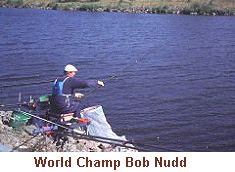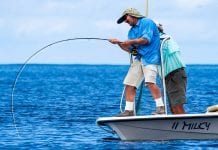For the angler aiming to improve and be capable of catching fish on a regular basis I think it fair to say it’s vital that he/she keeps an open mind. The more flexible the angler’s approach the better. 
For fish change their habits daily and often at times when we least expect it. The carp say, which found sweetcorn on the bottom irresistible yesterday, are now wanting a bait like dog biscuit on the surface? Those fickle bream might still be feeding but want a change bait from red maggot and don’t appear to like that ounce of lead on the feeder now the wind has dropped, etc.
If there is a golden rule it’s that the fish dictate the rules of the game and the angler must be ready and willing to change methods and tactics accordingly. If you decide how you’ll fish before you reach the bankside, then don’t adapt to suit the conditions on the day, your catches could suffer.
Being adaptable, thinking ‘laterally’, is one thing, but even the best don’t always make the right move at the right time. This is where experience counts. Former world coarse fishing champion Ian Heaps once used a slogan in a TV ad: ‘the more you know the more you catch’. It was a catchy one-liner, but I’d add a proviso: IF you can apply that knowledge to the way the fish are feeding at any given time.
Let me tell you about two milestones in my summer roach fishing, when I was given such a lesson that my fishing was never quite the same again. They both made me think hard about WHY fish feed in a certain way, and sharply defined the more subtle aspects of tackle presentation…
LESSON 1
Catching summer roach on the pole, sub-surface, with very light floats can be easy at times, then there’s the other days when missed bites, often from the bigger fish, slowly drive you up the wall.
If you have ever fished clear waters you must have seen it, when fish dart in to take all the loose-feed while ignoring the bait with the hook in it. Roach can suck in and blow out a maggot or caster as fast as you can blink anyway. Even when the tackle is streamlined to the limit – thin floats, tiny shots and hooks- – your most lightning-fast strikes always seem too slow.
So there I was on this warm spring day at Under-bank Reservoir, Stocksbridge (North-West Sheffield). The water had a dark, peaty tinge to it but it was clear. I could see the occasional fish pimpling on the surface, feeding on something, possibly little flies, but refusing my maggot hookbait.
After 90 minutes of trying on the pole I’d not caught a fish. I’d had a few nudges and plucks on the float, but nothing had developed into a clear bite. A fish might have mouthed the bait but had not left any visible damage, so they were obviously wary. 
Luckily, I’d just returned from a trip to France where I’d met the French international angler Jacky Morzieres. He had gifted me the most delicate little float I had ever seen, made from a half-inch piece of thin peacock with an extra-fine wire stem, all ready set up on a winder. The float was cocked to a pimple with three number 13 ‘micro’ shots. The hook was size 28 in extra fine wire. French matchmen, it deserves a mention, have fished exclusively for sticklebacks on some of France’s most polluted canals when there has been nothing else to catch. They have no peers at catching difficult roach on gossamer tackle.
After much head scratching, thinking that some fish were in the swim but with no idea of how to catch one, I remembered the little float. After cutting down the length of line above the float. I quickly attached the rig to my pole.
Casting a straight line wasn’t easy with the float being so tiny (using just three feet of line from pole to float) but I thrashed out the rig with an over-head swing. The float took ages to cock upright as the tiny shots settled in sequence in the 8ft swim. The short bristle finally sat upright as the last shot registered, then almost in the same movement it trembled and slid away. A bite.. .never? I struck and a 4oz perch was knocking solidly down below.
If that first perch wasn’t a great surprise, two more in subsequent casts certainly were and confirmed that I’d been fishing crudely for the situation – and to catch l2oz in just over a minute – remarkable!
The magic couldn’t last, obviously, and from that point the fish reverted to playing hard to get. But I kept catching the odd one and knew that the success was nothing to do with coincidence. I confirmed this by switching back to my original float later and it was so slow I could almost hear the fish laughing.
My first float was not huge, about a .2 gram capacity. I had caught loads of roach and perch with it and won matches in the bargain. My confidence in the tackle was therefore high.
But whether it was the very slow fall to the bait that the mini float gave, the extra light hook, or whatever (if only fish could speak?) it did the trick. And what a boost to my angling education. The float has saved my bacon several times since when I have been missing ‘unhittable’ bites. But do not think for a second that extra light is ALWAYS right for success with roach; heavier floats obviously have their moments too depending on various factors: depth, wind, water clarity, temperature and bait in use.
LESSON 2
Another lesson learnt was back in the early Nineties on the Pennine Championship, on Damflask Reservoir. This Sheffield water is gin clear and notoriously hard, having been described as ‘mean, moody and magnificent’ . Even when at its peak for roach fishing some years ago, out of 30 bites on the waggler you might hit five. That’s what I call a challenge.
The roach when they did show were in perfect condition and sizeable – regularly from 8oz to 1lb size, sometimes over the wonderful 2lb mark. Again they would respond to fine tackle – .08mm maximum trace line – and light shotting, for a nice slow fall to the bait.
On this particular match I caught 26 roach waggler a maggot for a weight of 7lb 8oz. This catch put me 9th out of 192 anglers and at that time if you finished in the top 20, apart from receiving an invite to a reception/prizegiving at Yorkshire Water’s Sheffield HQ, free food and drink, you won a nice memento like a clock or crystal classes for your mum. Worth trying for.
Now 7lb in the ‘Flask Champs’ was a decent weight. In over 10 years of trying I only beat it once and another time I won the match with a lower score.
BUT… .my next peg neighbour that day was Sheffielder Tony Wills, alias the ‘bubble man’. Despite complaints that his method (that is bubble feeder fished on a very slow drop) wasn’t working, Tony caught 12 roach. But those 12 roach weighed over 8lb! Tony came sixth in the match and won the section. How could he beat me with less than half my number of fish? Easy really when I pondered it afterwards, the bubble method is selective and would often sort out the bigger, craftier fish.
Before Tony and his method faded from the match scene he went on to break the five-hour and three-hour match records at Damflask. When breaking the five-hour record with 24lb of roach he also landed 38 trout that didn’t count! The method is also good for spotties as you can guess.
Generally, this feeder seemed to catch BIG roach better than other methods because the hookbait and feeder fell through the water a) at the same speed as the loose feed (feeder weighted so that it just sinks) and b) perpendicular with the surface. My hookbait on the waggler tackle however, like any floatfished bait, fell in an arc until it hung vertically below the float. And an arc isn’t as natural a direction for a maggot to fall in. 
I have since made bubble feeders for myself and caught plenty of fish with them. On it’s day – on a good lake when it’s warm and fish are boiling on the surface – it can be unbeatable. To prove how naturally the bait is presented the whole quiver-tip is usually yanked round 90 degrees when the fish takes!
Another key lesson on another day was when using the tiniest of hooks – a size 30. All the fish hooked were well inside the throat suggesting that they did not feel the hook’s weight. With most other small hooks (even as small as size 26) you usually lip-hook them. Again, it confirms that the difference between success and failure on roach, and I’m talking about average match size fish is a very fine line (no pun).
I have not yet taken heavy floatfishing to the limit (though have recently been sent a 24-gram float to test for Angling Star’s ‘Tackle Talk’ section – 15 swan shots approx.), but I have gone as far as I can down the scale with light tackle for roach, and finesse can make a big difference to results believe me.
So whatever your angling specialty, keep practicing, keep looking and listening, soaking up every scrap of information from your angling friends and trying things out for yourself. Eventually you will have one of those days like I did when all the pennies drop at once. You’ll be smiling all the way home and for a few days more. Your diary that day should be written up in capital letters. From this day on you’ll have new-found inspiration, believe me.












